
A long-standing puzzle on the origin of stardust recovered from meteorites has finally been solved thanks to the identification of the effect of a nuclear reaction in the composition of stardust grains.
During their lifetime, stars with masses four to eight times the Sun’s blow off their outer layers generating a nebula around them full of stardust and grains. The chemical composition of such dust and grains reveals important clues on the nuclear processes that have contributed to their formation.
The Solar System is believed to have formed from such a nebula. And while most of the original dust was destroyed to make up new rocks and planets, including the Earth, a small fraction survived the destruction process. This special dust, recovered from meteorites, can be used to trace the evolution of the nebula from which the planets were born and to understand the physical processes inside the stars where the grains formed. But tracing the grains to specific types of stars turned out to be surprisingly difficult.

While intermediate mass stars (roughly six times heavier than the Sun) are seen by infrared telescopes to produce huge amounts of dust, however, grains recovered from the Solar System meteoritic record so far did not seem to match the composition expected from these stars.
A new study, led by Maria Lugaro from Konkoly Observatory (MTA-CSFK) and published in Nature Astronomy, solves this problem by identifying, in the make-up of some meteoritic stardust grains, the effect of the nuclear reactions that occur in these particular stars.
The breakthrough was possible thanks to experiments carried out at the Laboratory for Underground Nuclear Astrophysics (LUNA). LUNA observed that the probability for the fusion of protons and 17O (a heavier type of the oxygen we breathe) to occur is twice as large as previously thought (Bruno et al., Physical Review Letters, 117, (2016) 142502). This effect is clearly observed in some stardust grains, resolving the mystery of the missing grains from intermediate-mass stars.
LUNA is currently the only underground accelerator worldwide specifically devoted to the study of nuclear reactions of astrophysical interest. The facility is hosted by the Laboratori Nazionali del Gran Sasso of the Italian Institute for Nuclear Physics (INFN) and is located under more than one kilometer of rocks.
Maria Lugaro says: “The long-standing question of the missing dust was making us very uncomfortable: it undermined what we know about the origin and evolution of dust in the Galaxy. It is a relief to have finally identified this dust thanks to the renewed LUNA investigation of a crucial nuclear reaction.”
“The results of this study prove once again the importance of precise and accurate measurements in the laboratory of the nuclear reactions that take place in stars – says Prof Marialuisa Aliotta, who led the UK team of LUNA for the PRL study – It is a great satisfaction to know that we have contributed to solving a long-standing puzzle on the origin of some stardust grains.”
LUNA is an international collaboration, involving about 40 scientists from 14 institutions in Italy, Germany, Hungary and the UK. The Collaboration Spokesperson is Prof Paolo Prati, from the University of Genova, Italy.
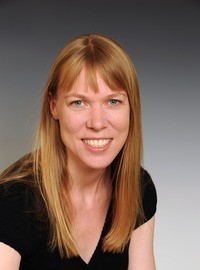
The Institute for Astronomy's Prof. Catherine Heymans has been awarded the 2017 George Darwin Lectureship by the Royal Astronomical Society. The Lecture is given annually, on a topic in astronomy, cosmology or astroparticle physics.
Professor Catherine Heymans is a world-leading observational cosmologist who is well known for her innovative and ground-breaking work in the field of weak gravitational lensing. In recognition, she holds a Personal Chair at the University of Edinburgh. She is the principal investigator for two successive major research grants from the European Research Council that support her team’s research on the Dark Universe and Beyond Einstein Gravity Theories. Since completing her PhD in 2004, Prof. Heymans has co-authored over 100 well-cited articles in peer-reviewed journals. She is a founding member of the Young Academy of Scotland. Professor Heymans is devoted to promoting the public’s understanding of her research. She has appeared in a wide range of events, at numerous Science Festivals, and has written a number of articles for the popular Institute of Physics science magazine 'Physics World'. Her TEDx talk on the Dark Side of the Universe has had over 8000 views on YouTube showing that she is an accomplished public speaker. For these reasons, Professor Heymans is awarded the George Darwin Lecture.
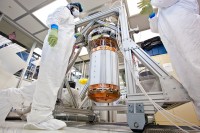
The Large Underground Xenon (LUX) dark matter experiment, which operates beneath a mile of rock at the Sanford Underground Research Facility in the Black Hills of South Dakota, has completed its search for the missing matter of the universe – one of the most sought for goals in physics and astronomy. Final results are published in Physical Review Letters, with an editorial comment to highlight their significance.
Since 2013, the experiment has led worldwide direct searches for dark matter, in which evidence for the scattering of dark matter particles in a terrestrial detector is sought. The final result from the 2014-2016 run, recently accepted for publication in PRL, pushes the sensitivity of the instrument to a final performance level that is 4 times better than originally expected, and a further improvement on its existing world lead. Despite seeing no sign of a signal, the results rule out large fractions of the theoretical parameter space, constraining tightly the nature of dark matter.
Data analysis continues, searching for other possible rare signals in the data. The instrument itself is now being decommissioned and removed from the deep underground laboratory, in preparation for installation of its successor, LUX-ZEPLIN. Expected to begin taking data in 2019, this instrument is over twenty times larger, and expected to be over a hundred times more sensitive still. The University of Edinburgh is one of the leading institutions in LUX, contributing the Executive Chair of the collaboration, and is a participant in LZ.
These results reflect that LUX is now some twenty times more sensitive to dark matter than any of its predecessors. While if Nature had been kinder, we might have made a discovery, our results have greatly narrowed the possibilities for what dark matter might be - itself an important result. A new generation of experiments are now coming online or being built, including our own LUX-ZEPLIN. The search for dark matter remains a top priority. Says Prof Alex Murphy, The University of Edinburgh
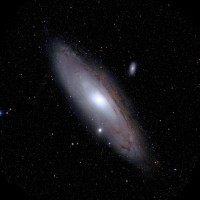
Astronomers around the world are poised to discover billions of new stars, galaxies and solar system objects, thanks to newly released data from a major survey of the skies involving University of Edinburgh researchers.
Scientists are poised to make fresh discoveries about the Universe, thanks to newly released data from a major astronomy survey. Results from a four-year project to capture digital images of the sky should enable astronomers around the world to discover billions of new stars, galaxies and solar system objects. The project, involving Edinburgh scientists, will also enable researchers to study the farthest reaches of the universe and gain insights into elusive dark energy and dark matter.
Images in the study have been taken using a 1.8-metre telescope at the summit of Haleakalā on Maui, Hawaii. The technology is known as the Panoramic Survey Telescope & Rapid Response System (Pan-STARRS). It captured images of patches of sky - each about 36 times the area of the moon - every 30 seconds for four years. The telescope’s regular imaging means that fast moving objects and exploding stars can be tracked across nearly the whole sky. Images from the project, being released by the Space Telescope Science Institute and the University of Hawaii, can be analysed to identify and catalogue astronomical objects. Data from the survey has been shared in advance with astronomers in the team. Already, this has led to discovery of hundreds of supernovae – exploding stars that give off massive amounts of energy as they die. It has enabled scientists to see individual stars in nearby galaxies, and to discover giant streams of stars in our own Milky Way. The survey dataset is being released in two stages. The first gives an average value for the position, brightness, and colours of all the recorded objects in the sky at a particular point in time.
A further release next year will provide a catalogue of information, and allow access to individual images for each time frame. The database will include information on individual snapshots of a given region of sky.
The Pan-STARRS project was undertaken by an international collaboration including the Universities of Edinburgh and Durham, and Queen’s University Belfast.It was supported by NASA and the National Science Foundation.
“This rapid, repeating survey has enabled us to discover very rare events in which a massive black hole shreds a passing star, which otherwise would have been impossible to spot. Releasing the data will now enable astronomers round the world to study huge numbers of distant stars and galaxies in ways we can't even guess." said Professor Andy Lawrence, of the University’s School of Physics and Astronomy
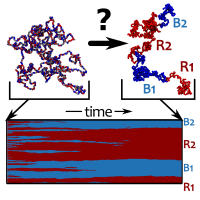
A new theoretical model of DNA as a "recolourable" polymer may explain why specific "epigenetic" patterns on the genome can survive from one cell generation to the next and allow cellular memory.
Every cell in our body contains the same DNA. Nevertheless, a brain cell is clearly very different from, say, a liver cell, in terms of which genes are active and inactive. The specialisation into different types of cells is made possible by "epigenetics" (literally, "beyond the genetic information"). Epigenetics acts through biochemical markers called "post-translational modifications" which are deposited onto histone proteins -- the proteins needed to package the DNA inside the nucleus. Epigenetic marks vary from cell to cell, allowing each cell to have its own identity. Nonetheless, epigenetic marks are very dynamic: they are gained and lost by histones all the time, and many are removed during replication. This then begs the questions, how does a cell remember its own identity throughout its life and how is its identity passed down to the progeny cells when it divides?
Davide Michieletto, in collaboration with Davide Marenduzzo and Enzo Orlandini (Padova) have formulated a new model to address these questions. The model treats the complex of DNA and histones (also called "chromatin") as a polymer made of beads, where each bead corresponding to a few histones (with their corresponding DNA). In the model, the polymer beads are "coloured" based on their epigenetic state, and this can be changed dynamically mimicking the action of "writer" proteins, enzymes found in the cell. The epigenetic colour is then recognised by "readers", which model chromatin-bridging proteins which have an affinity for a given epigenetic mark. The model displays an abrupt first-order-like transition between a swollen and epigenetically "disordered" chromatin and a collapsed and "ordered" one, where the whole polymer has the same colour. The first order nature of the transition is important: it implies that there is hysteresis and memory, and the researchers have shown that, following a (simulated) replication event, the system is able to return to the same ordered state (so the corresponding cell will keep its identity).
The findings therefore strongly suggest that epigenetic memory may be made possible through a positive feedback loop between "reader" and "writer" proteins which couple the 1D epigenetic patterning to the 3D chromatin folding.
Dark matter, the elusive material that accounts for much of the Universe, is less dense and more smoothly distributed throughout space than previously thought, according to a new study co-led by astronomers at the University of Edinburgh. The international team of scientists studied wide-area images of the distant universe, taken from the European Southern Observatory in Chile. They applied a technique based on the bending of light by gravity - known as weak gravitational lensing - to map out the distribution of dark matter in the Universe today. Their study represents the largest area of the sky to be mapped using this technique to date.
The new results contradict previous predictions from a survey of the far-off universe, representing a point in time soon after the Big Bang, imaged by the European Space Agency's Planck satellite. This previous study used a theoretical model to project how the Universe should appear today. The disagreement between this prediction and the latest direct measurements suggests that scientists' understanding of the evolving modern day Universe is incomplete and needs more research.
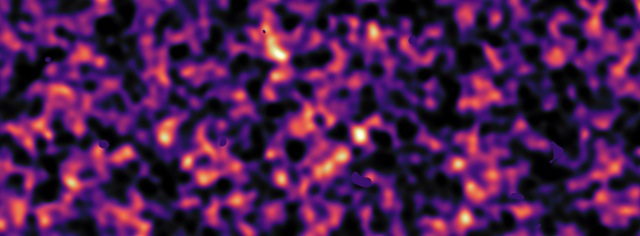
The latest study, published in Monthly Notices of the Royal Astronomical Society, was carried out by a team jointly led by the University of Edinburgh, the Argelander Institute for Astronomy in Germany, Leiden University in the Netherlands and Swinburne University of Technology, Australia in an ongoing project called the Kilo Degree Survey, or KiDS. It was supported by the European Research Council.
"Our findings will help to refine our theoretical model for how the Universe has grown since its inception, improving our understanding of the modern day Universe.” says Dr Hendrik Hildebrandt of the Argelander Institute for Astronomy in Germany.
"This latest result indicates that the cosmic web dark matter, which accounts for about one-quarter of the Universe, is less clumpy than we previously believed.” said Dr Massimo Viola of Leiden University in the Netherlands.
"Unravelling what has happened since the Big Bang is a complex challenge, but by continuing to study the distant skies, we can build a picture of how our modern Universe has evolved.” said Professor Catherine Heymans of the University of Edinburgh's School of Physics and Astronomy.
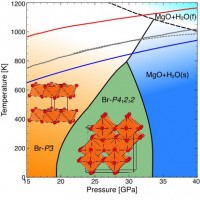
Water inside Earth’s interior is crucial to assist mantle convection. Without it, mantle convection would be inefficient, volcanic activity would cease, as would plate tectonics on the surface.
Hydrous minerals help transport water deep into Earth’s mantle, and form part of a cycle that regulates the sustained presence of water, both in the interior and on the surface, on geological time scales. To understand the deep-water cycle, it is crucial to study the properties of hydrous minerals under the conditions present in Earth’s mantle. Brucite, chemical formula Mg(OH)2, is one of the simplest hydrous minerals and stores significant amounts of water in the form of hydroxyl groups. It is assumed to decompose in the mantle transition zone, but recent work by Dr Andreas Hermann, with collaborators from Florida State University, shows that the mineral can exist in a more compact high-pressure phase instead, which pushes the stability region of brucite several hundreds of kilometers deeper and into the lower mantle. Brucite might be present at much greater depths, and in much larger quantities, than previously thought. This changes the current thinking about the water storage capacity of the deep Earth, and the role hydrous minerals play in transporting and holding water inside our planet.
The work involved quantum-mechanical calculations that screened thousands of potential crystal structures of brucite under extreme pressure conditions. The new phase, which has a network structure akin to anatase, emerged eventually from those calculations. Besides being more stable than the known brucite structure at high pressures and temperatures, Dr Hermann and his collaborator showed that the new phase has a unique elastic response, which might enable its direct detection in seismic signatures, as well as specific vibrational properties that should make its detection in laboratory experiments straightforward.
The research is published in the Proceedings of the National Academy of Sciences.
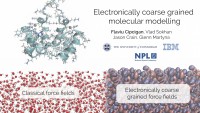
Flaviu, who is a final year CASE student with NPL has won the thesis presentation award at the first NPL Post Graduate Institute for his presentation titled 'Electronically Coarse Grained Molecular Modelling'.
Congratulations to Flaviu for winning the best presentation award at the first annual Postgraduate Institute conference at NPL. The conference was attended by 150 delegates over two days, comprising postgraduate researchers based both at NPL and partner universities, their supervisors, invited guests and speakers.
A number of the postgraduates also took part in a challenge to describe their doctoral work comprehensively in just three minutes, with just one slide. The winner was Flaviu Cipcigan, for his presentation 'Electronically Coarse Grained Molecular Modelling',

Warm inflation is an alternative and simpler dynamical picture for the the early Universe, in which the dominant expansion period occurs in a warm phase, whereas in the standard inflation picture, accepted for over three decades, it occurs in a cold phase. This leads to distinct differences in the history of the early Universe and present-day observational signatures.
For over the two decades since warm inflation was suggested by Arjun Berera, experts in the fields of cosmology and particle physics have regarded it as almost impossible to realize this idea in a simple first principles model. This paper has confounded these expectations and developed a simple and compelling first principles model of warm inflation. This now provides a solid theoretical foundation to an alternative paradigm for the early Universe, which shows excellent agreement with large scale observational data (see figure below).

In standard inflation, any preexisting radiation is stretched and dispersed during a brief cosmic phase and no new radiation is produced. The Universe’s temperature plummets by several orders of magnitude, and an ensuing reheating period fills the Universe with radiation again. Warm inflation is simpler. New radiation is constantly produced by the decay of the scalar field that triggers inflation, the inflaton; the temperature remains large; and there is no reheating phase. Ironically, however, models of warm inflation have so far required thousands of additional fields to be coupled to the inflaton to avoid large corrections to its mass.
This paper treats the field driving inflation as a pseudo Nambu-Goldstone boson of a broken gauge symmetry and its mass is naturally protected against large quantum and thermal corrections. The model is similar to the Little Higgs mechanism for electroweak symmetry breaking. Using this idea Berera and colleagues built a model involving only four additional fields and no mass corrections. The researchers then compared the model’s observational predictions with constraints on inflation derived from Planck satellite measurements of the cosmic microwave background radiation and found good agreement between the two. The presence of radiation during inflation has been known from very earlier work by Berera and colleagues to lower the tensor-scalar ratio. This model realises this result in a compelling first principles model, thus accommodates the possibility for a tensor mode anywhere from the present upper bound to a value extremely below that.
The latest research is published in Physical Review Letters and was highlighted by the journal as an Editors' Suggestion, which recognises its important contribution to the field.

On Saturday 26th September the School took part in Door Open Day with two popular exhibits and a successful recruitment day.
Institute for Condensed Matter and Complex Systems once again threw open the doors to its laboratories for Doors Open Day 2016. Visitors were able to see how complex fluids are studied using rheology, watch food based capsules being made and see the group’s new confocal microscope in action. In the foyer, younger visitors made slime and lava lamps, learning about non newtonian fluids and interfacial phenomena. A popular favourite, a large bucket of corn flour in water dramatically illustrated shear thickening. Well away from the corn starch, highlighted the biophysics research of the group, including an interactive simulation of bacterial population dynamics. A team of 12 PhD students and postdocs from the ICMCS ran the event and talked enthusiastically to visitors about their work.
PP4SS (Particle Physics for Scottish Schools) had successful display in the JCMB cafe with good in visitor numbers.

